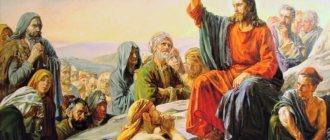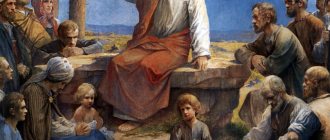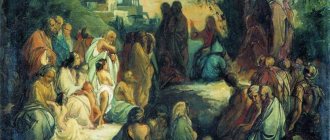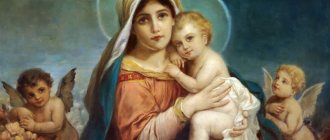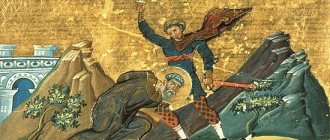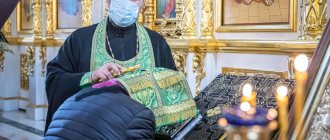“We can’t predict”
Through the work of artists such as Vasily Polenov, many people of my generation came to faith. Polenov created a whole series of paintings called “From the Life of Christ ,” where he talks about the events from the birth to the death of the Savior. And his paintings revealed the gospel story to many.
V. D. Polenov with his younger daughters Olga and Natalya, 1902 Vasily Polenov. Gallery of paintings, photos and drawings by the artist
After a huge break in the religious tradition, when people lost faith, when the prayer life for the majority of the population of our country ended, many people developed a strong religious thirst. In 1988, when the 1000th anniversary of the Baptism of Rus' was celebrated, the topic of Christianity, which had long been taboo for society and was not included in art criticism (many art historians did not analyze works related to Christianity), finally became accessible. Especially for this date, an exhibition was organized at the Polenov Museum, and most of it consisted of reproductions of gospel paintings “From the Life of Christ.”
And I remember that I had to endlessly tell visitors not so much about Polenov’s artistic method or how exactly he interpreted the Gospel stories, but about the events that took place in that distant era.
Polenov portrayed the Gospel events delicately and unobtrusively, and this allowed even an unprepared person to understand what and Who they were about. The world of icons was difficult for many at that time: this required spiritual experience, basic knowledge of Orthodox culture. And here before us were paintings that depict a real person in real conditions, in Palestinian nature, and interest involuntarily arose, questions arose. And then, for those who seriously began to look for answers, the meaning of the Gospel and Christian life was gradually revealed.
Polenov himself hardly suspected what role his works would play years later, because his religious views were complex. But as often happens when a great artist works, he cannot know about the final result of his work. “It is not given to us to predict...” - Tyutchev said about the power of words, the same is true here when it comes to art with a capital “A”.
Where there is no place for miracles
Vasily Polenov showed his gospel cycle “From the Life of Christ” at an exhibition in 1909, a year before the death of Leo Tolstoy. Polenov, who cared about the opinion of the writer he revered, sent Tolstoy an album with photographs of his works, which he himself colored by hand, since the photographs were black and white.
And although Lev Nikolayevich had a difficult attitude towards the artist’s art, he nevertheless appreciated this album and said: “I see a great merit in this, including pedagogical: these paintings would be a good illustration for my gospel.”
What made Tolstoy respond to Polenov’s work this way? Why are these paintings a reflection of his gospel and not the true Holy Book?
Vasily Polenov. “She brought joy to those who mourn.” 1890
Let's look at Polenov's works from the gospel cycle: according to the chronology of events, the first of them is “Mary went to the Mountainous Country.” Polenov depicts the Virgin Mary as a young woman who walks with a bundle in her hands along a narrow path and, as we assume, to meet Elizabeth. The last picture is “She Announced Joy to the Weeping,” where Mary Magdalene, having seen that the tomb of Christ is open and empty, announces to the weeping: Christ is Risen! But where is Polenov’s Risen Lord? He's gone. In the artist’s cycle there is no miraculous Birth, no miraculous Resurrection, no miracles of healing - no miracles at all.
The archives of the Tretyakov Gallery contain quite a lot of letters from Vasily Dmitrievich and his relatives. From them we know that he treated religion like many “advanced” people of that time. It is now easy for us, who have the terrible 20th century behind us, to judge that era and many of its misconceptions - we have a completely different experience. But it was very difficult for the people who lived at that time: doubts assailed them more and more, and the experience of secular culture had a great impact.
Vasily Polenov. Palestine. Sermon on the Mount. 1890
The books of European thinkers who captured the minds of the Russian intelligentsia played a huge role in undermining faith. For example, Ernest Renan, who took the position that Christ is just a historical figure, and everything else is a myth that was invented after His death. Or David Friedrich Strauss, who tried to logically prove the fictionality of all Gospel miracles, said that the Gospel is a myth, it is absolutely the same as the myths of Ancient Greece, and there is no historical basis here.
Polenov talked a lot about religion, he was interested in its history, truth was important to him - but he understood truth as a scientific discovery, he needed evidence (not only he thought so, but also many others who were confused by the rapid development of science and replaced faith with an attempt to scientifically explain all the secrets of the world). He argued a lot both with himself and with religious philosophers, but always adhered to his original point of view. Of course, based on the views of those thinkers who impressed his own perception of the gospel events.
Lev Nikolaevich Tolstoy had a great influence on Polenov’s religious views. It is no coincidence that Vasily Dmitrievich, according to his youngest daughter, did not like Dostoevsky, for whom everything is Christ-centric. Polenov was much closer to Tolstoy and his focus on moral improvement.
The Savior calls to balance the material and spiritual
Jesus Christ warns people against becoming fixated on material wealth:
“Do not lay up for yourselves treasures on earth, where moth and rust destroy and where thieves break through and steal, but lay up for yourselves treasures in heaven, where neither moth nor rust destroys and where thieves do not break through and steal, for where your treasure is, there your heart will also be"
(Matt. 6:19–21)
Jesus Christ called not to make a cult out of earthly goods, but to approach them wisely.
After all, nothing lasts forever. Only the inner world of a person is his eternal wealth.
“The lamp for the body is the eye. So, if your eye is clean, then your whole body will be bright; if your eye is bad, then your whole body will be dark. So, if the light that is in you is darkness, then what is the darkness?”
(Matt. 6:22–23)
The heart is a person’s lamp in the darkness of ignorance. But if you plunge this heart into the same darkness, then you will no longer be able to get out of it.
Jesus does not deny the importance of the material world, but calls not to serve it, not to become its slave:
“No one can serve two masters: for either he will hate one and love the other; or he will be zealous for one and neglectful of the other. You cannot serve God and mammon.”
(Matt. 6:24)
A believer needs to take care of those things over which he has control, and let go of what cannot be changed. Of course, it is not good when there are hungry and thirsty people.
Therefore, Christ never calls for throwing away life and mortal body.
But you can't submit to all this.
Ultimately, the only important question will be whether the person took care of the soul:
“Therefore I say to you, do not worry about your life, what you will eat or what you will drink, nor about your body, what you will wear. Is not the life more than food, and the body than clothing?
Look at the birds of the air: they neither sow nor reap, nor gather into barns; and your Father in heaven feeds them. Aren't you much better than them? And which of you, by caring, can add one cubit to his height?
And why do you care about clothes? Look at the lilies of the field, how they grow: they neither toil nor spin; but I tell you that Solomon in all his glory was not dressed like any of them; But if God clothes the grass of the field, which is here today and tomorrow is thrown into the oven, then God will clothe it more than you, O you of little faith!
So do not worry and say, “What shall we eat?” or what to drink? or what to wear? because the pagans seek all these things, and because your Father in heaven knows that you need all these things.”
(Matt. 6:25–32)
Jesus Christ during the Sermon on the Mount (“Sermon on the Mount”. Painting of the Church of Saints Cosmas and Damian in Shubin, Moscow). Photo: bigenc.ru
Therefore, it is important to set priorities correctly, do good deeds and seek the Kingdom of God:
“Seek first the kingdom of God and His righteousness, and all these things will be added to you. So do not worry about tomorrow, for tomorrow will worry about its own things: each day’s own care is enough.”
(Matt. 6:33–34)
Who was Christ for Polenov?
Moral ideal. A real ordinary person who lived on earth, whose death led to the appearance of a grandiose book called the Gospel with its highly moral preaching.
Polenov’s youngest daughter, Natalya Vasilievna, argued that for her father, the earthly life of Jesus Christ was always the standard, His personality was ideal and harmonious. A person, according to Polenov, should strive for this standard and, moreover, he can achieve it.
This is the deep and at the same time daring idea that the artist adhered to. We see this idea in his work: here Christ was born, here He works - and here, finally, is His heroic death.
Vasily Polenov. Among the teachers. 1896
Polenov has a painting “Among the Teachers,” which is kept in the Tretyakov Gallery. Its plot is clear: Mary and Joseph, returning from a holiday in Jerusalem, lose the twelve-year-old boy Christ, thinking that He is walking somewhere nearby in the crowd, among people, but they do not find him; They search for three days and, returning to Jerusalem, find him among the teachers. There is an icon of the Midnight of Pentecost, where Christ the Youth is depicted on the throne in the center, and teachers sit around him. Polenov portrays this plot completely differently. First of all, you pay attention to the deep opening where Mary and Joseph are depicted and where a beautiful view opens up, and only then you turn your gaze to the boy who is sitting surrounded by elders.
When I started researching Polenov’s art, I thought for a long time about what this painting could mean, why he paints it in this particular way - and why does he work on it in such detail? Of course, Polenov was tormented by the question of how to explain that this “simple carpenter” could create such a teaching that has continuously captivated people for so many centuries. How is this possible?! And being completely perplexed by this question, Polenov solves it in a purely human way: he places little Christ in the center and, as it were, shows that He took a little from this sage, from another, from a third - and as a result of such influence, or let’s say, His teaching was formed by comprehending the tradition.
Vasily Polenov. Dreams. Jesus on Lake Gennesaret. 1894
There is no talk about grace, about the Divine essence of Christ. Therefore, when you look at the Gospel cycle, in one picture He sits on a rug near the open door of a small room where the Talmud is read, in another early in the morning He stands on a mountain, admiring the rising sun, and, as Renan naively writes, this nature, this sun is so acted on Him, resulting in such a beautiful, humane teaching. And the people of the generation to which Vasily Dmitrievich Polenov belonged believed in this: there could be nothing supernatural.
Polenov has a lot of discussions about how to portray Christ. And he comes to the conclusion that Christ in his paintings must be outwardly healthy and attractive - because the person who created such a teaching cannot be flawed in some way, he must be a harmonious, beautiful person.
Therefore, in all his works we see this type of image of Christ as a man, attractive in appearance and rich spiritually.
Mount of Beatitudes
The mountain on which the Sermon on the Mount was delivered was called the “Mount of Beatitudes.” Although there are no real mountains in this part of Galilee, there are several large hills to the west of Lake Galilee.
Additionally, some scholars believe that the Greek word used in Matthew 5:1 is more accurately translated as “mountainous region” or “hills” rather than simply “mountain.”
According to ancient Byzantine tradition, this was Mount Karnei Hittin (lit. "Horns of Hittin", as it has two peaks), which is located on the route between Tabor and Capernaum, about 6 km west of Tiberias.
Following the Byzantines, the Crusaders also thought so, and the Catholic Encyclopedia still insists on this version. G
Russian Orthodox tradition also considers the slopes of this mountain to be the site of the Sermon on the Mount.
During Napoleon's time, some believed that the Mount of Beatitudes was Mount Arbel, located on the western shore of Lake Galilee, south of Capernaum.
Since the middle of the 20th century, after the construction of a Catholic church dedicated to the Beatitudes on the top of Mount Nakhuma, in close proximity to Tabgha, it became known as the Mount of Beatitudes.
The mountainside is an amphitheater with good acoustics. Today, Christian pilgrims of all faiths and simply tourists visit this peak as the Mount of Beatitudes.
St. Augustine, in his commentary on the Sermon on the Mount, speaks of the parallel of this sermon with the ascent of Moses to Mount Sinai. He believes that such symbolism points to Jesus Christ as fulfilling the commandments of Moses.
“Your mission for centuries is not clear to you”
In addition to a series of gospel paintings, Vasily Dmitrievich wrote the book “Jesus from Galilee”: he attempted to compile a set of four canonical Gospels. As Polenov himself wrote, he decided to combine all four Gospels into a single whole, taking the same principle that he followed in his pictorial work: from the birth of Christ to His death (by the way, Tolstoy tried to do the same thing, who decided to write a materialistic gospel) .
Christ. Sketch for the painting “Which of you is without sin?” 1888
But when he showed this work to his close friend, a historian who, apparently, was also involved in the history of religion, Valery Nikolaevich Lyaskovsky, he analyzed it and made a lot of edits: his comments took up about 15 typewritten sheets. In his letter to Polenov, he says: “You probably in your work do not understand the essence of Christ, His divine-human nature and are trying in every possible way to move away from this topic, to avoid it. But you, nevertheless, are the son of the Gospel, who said: “I will not go,” but went himself. For your mission throughout the centuries is not clear to you, but you serve according to the word of Him who said: heaven and earth will pass away, but My words will not pass away (Mark 13:31)».
In another of his letters, Lyaskovsky asks Vasily Dmitrievich: “You always turn to the works of Renan, Reville, but have you read other theological literature written over so many millennia: the Fathers of the Church, or at least Khomyakov?” Vasily Dmitrievich did not turn to this literature; it did not interest him very much, since he was completely unable to penetrate its structure and understand what it was about.
Christian Constitution - Jesus' Sermon on the Mount
(4:25 And large crowds followed Him from Galilee, and the Decapolis, and Jerusalem, and Judea, and the regions beyond the Jordan. 5:1) / And He, seeing these crowds, ascended the mountain;
2 And when He sat down, His disciples came to Him./And He opened His mouth and began to teach them thus:
3 “Blessed are the poor at the commandment of the Spirit, for theirs is the Kingdom of Heaven.
4 Blessed are those who mourn, for they will be comforted.
5 Blessed are the meek, for they will take the earth as an inheritance.
6 Blessed are those who hunger and thirst for righteousness, for they will be satisfied.
7 Blessed are the merciful, for they will receive mercy.
8 Blessed are those whose hearts are pure, for they will see God.
9 Blessed are the peacemakers, for they will be called sons of God.
10 Blessed are those who are persecuted for righteousness’ sake, for theirs is the kingdom of heaven.
11 Blessed are you when reproach and persecution are raised against you, and every evil word is spoken against you falsely, 12 because of Me./ Rejoice and be glad, for great is your reward in heaven! So they persecuted the prophets who were before you.
13 You are the salt of the earth; but if the salt has become unleavened, how can you salt it? It's not good for anything; unless you throw it out for people to trample underfoot.
14 You are the light of the world. A city standing high on a mountain cannot hide.
15 And the lamp is lit, not to be placed under a bushel, but on a lampstand, so that it may give light to everyone in the house.
16 Let your light shine before men, so that they may see good works from you and glorify your Father who is in heaven.
17 Do not think that I came to abolish the Law or the Prophets; I did not come to abolish, but to complete.
18 For truly I say to you, until heaven and earth pass away, not one jot or one tittle will pass from the Law, until everything is fulfilled.
19 Therefore, if anyone breaks the very last of these commandments and teaches others to do the same, he will be named last in the Kingdom of Heaven; and whoever does and teaches will be called great in the Kingdom of Heaven.
20 For I say to you, unless your righteousness is greater than the righteousness of the scribes and Pharisees, you will not enter the kingdom of heaven.
21 You have heard that it was said to the ancients: “You shall not kill,” but if anyone kills, he will answer before the court.
22 But I tell you that everyone who is angry with his brother will answer before the court; and if someone says to his brother: “Cancer!” - will give an answer before the Sanhedrin; and if anyone says to his brother, “You fool!”, he will give an answer in the fire of Gehenna.
23 Therefore, if you bring your gift to the altar, and there you remember that your brother has a grudge against you,
24 Leave your gift there before the altar, and first go and make peace with your brother, and then come and offer your gift.
25 Know how to please the plaintiff while you are still on the way to court, so that the plaintiff does not deliver you to the judge, and the judge to the jailer, and so that you are not thrown into prison:
26 Truly I tell you, you will not leave there until you pay the last coin.
27 You heard that it was said, “You shall not commit adultery.”
28 But I tell you that anyone who looks at a woman with lust has already committed adultery with her in his heart.
29 So if your right eye causes you to stumble, pluck it out and throw it away; for it is better for you that part of your body should perish, and not that your whole body should be cast into Gehenna.
30 And if your right hand causes you to stumble, cut it off and throw it away; for it is better for you that part of your body should perish, and not that your whole body should go to Gehenna.
31 It was said: whoever divorces his wife is obligated to give her a certificate of divorce.
32 But I tell you that whoever divorces his wife except because of her unfaithfulness causes her to commit adultery, and whoever marries a divorced woman commits adultery.
33 You have also heard that it was said to the ancients: “Do not swear a false oath, but fulfill your oaths to the Lord.”
34 But I say to you, do not swear at all, not even by heaven, for it is the throne of God,
35 neither by the earth, for it is the footstool of His feet, nor by Jerusalem, for it is the City of the great King;
36 And do not swear with your head, for it is not in your power to make a single hair white or black.
37 But let your word be: “yes, yes,” “no, no”; and what is beyond this is from the Evil One.
38 You have heard that it was said, “An eye for an eye, and a tooth for a tooth.”
39 But I tell you, do not resist an evil person, but if someone hits you on your right cheek, offer him the other.
40 And if anyone wants to sue you for your shirt, give him your cloak too,
41 And if someone imposes on you the duty of accompanying him a mile, go with him for two.
42 Give to anyone who asks from you, and do not turn away from anyone who wants to borrow from you.
43 You have heard that it was said, “You shall love your neighbor and hate your enemy.”
44. But I tell you: love your enemies and pray for those who persecute you,
45 That you may become children of your Father who is in heaven; for He makes His sun appear on the evil and on the good, and sends rain on the just and on the unjust.
46 For if you love those who love you, what merit will you have? Don't publicans do the same?
47 And if you are only friendly with your own people, what's the big deal? Don't the pagans do the same?
48 But you must be perfect, just as your Father in heaven is perfect.
6:1 And take heed to yourselves, that you do not perform righteous works for show, for spectators; Otherwise you have no reward with your Father who is in heaven.
2 So, if you do a good deed, do not make a noise, as the actors do in the synagogues and in the streets, seeking praise from people. Truly I tell you, they have received their reward in full.
3 But when you do a good deed, do not let your left hand know what your right hand is doing,
4 so that your good deed may be hidden; and your Father, who sees the unseen, will reward you.
5 And when you pray, do not be like the actors who love to stand at prayer in the synagogues or at the crossroads so that people can see them. Truly I tell you, they have received their reward in full.
6 But when you pray, go to your room, closing the door behind you, and pray to your Hidden Father; and your Father, who sees the unseen, will reward you.
7 But when you pray, do not mumble, as the heathen do; because they think that if there are many words, they will be heard.
8 So do not be like them; For your Father knows what you need before you ask Him.
9 Therefore you pray like this: Our Father who art in heaven! Hallowed be Thy Name,
10 Thy kingdom come, Thy will be done, on earth as it is in heaven;
11 Give us today our daily bread,
12 And forgive us our debts, as we forgive our debtors,
13 And lead us not into temptation, but deliver us from the Evil One.
14 For if you forgive people what they have done wrong, your Heavenly Father will also forgive you;
15 But if you do not forgive people, your heavenly Father will not forgive you what you have done wrong.
16 And when you fast, do not put on yourselves, like actors, a gloomy appearance; after all, they make sad faces for themselves to show people how they are fasting. Truly I tell you, they have received their reward in full.
17 But when you fast, anoint your head and wash your face,
18 not to show people how you fast, but to your Hidden Father; and your Father, who sees the unseen, will reward you.
19 Do not store up for yourselves treasures on earth, where moth and rust eat away and thieves break in and carry away;
20 But store up for yourselves treasures in heaven, where neither moth nor rust corrupts, and where thieves do not break in and carry away;
21 For where your treasure is, there will your heart be also.
22 The lamp of the body is the eye. So, if your eye is sound, your whole body will be filled with light;
23 But if your eye is unclean, your whole body will be filled with darkness. But if the light that is in you is darkness, how dark is the darkness itself!
24 No one can serve two masters; either he will reject one and love the other, or he will be devoted to the first, but negligent for the second. You cannot serve both God and wealth.
25 Therefore I say to you, do not worry about your life, what you will eat and drink, nor about your body, what you will wear; Is not life more than food, and the body than clothing?
26 Look at the birds of the air, that they do not sow, nor reap, nor store up storehouses, and yet your heavenly Father feeds them; and you, aren’t you much more valuable than them?
27 And who among you can add even one cubit to his life by his troubles?
28 And why are you bothering about clothes? Look how the flowers grow in the field - they don’t work, they don’t spin;
29 But I tell you that Solomon in all his glory was not dressed like any of these./
30 But if God so clothes the grass of the field, which today exists and tomorrow is thrown into the oven, how much more so than you, O you of little faith?
31 So, do not bother saying, “What shall we eat?”, or, “What shall we drink?”, or, “What shall we wear?”
32 Such concerns occupy the Gentiles; but your Heavenly Father knows that you need all this.
33 Take care first of all about the kingdom and its righteousness, and all this will be given to you in addition.
34 So, do not worry about tomorrow, for tomorrow will worry about itself; Every day has enough of its burdens.
7:1, Do not judge, lest you be judged:
2 For with the judgment you judge, you will be judged, and with the measure you use, it will be measured back to you.
3 Why do you look at the speck in your brother's eye, but do not notice the beam in your own eye?
4 Or how will you say to your brother, “Let me take the speck out of your eye,” when there is a plank in your own eye?
5 You actor, first remove the plank from your own eye, and then you will see clearly to remove the speck from your brother’s eye.
6 Do not give what is holy to dogs, and do not scatter your pearls before swine, lest they trample them under their feet and attack you and tear you to pieces.
7 Ask, and it will be given to you; seek and you will find; knock and it will be opened to you.
8 For everyone who asks receives, and whoever seeks finds, and whoever knocks, the door will be opened to him.
9 Is there a man among you whose son asks for bread, and he gives him a stone?
10 Or will he ask for a fish, and he will give him a snake?
11 So if you, evil people, know how to give good gifts to your children, how much more will your Father who is in heaven give good things to those who ask Him?
12 Therefore, in everything, do to people as you would have them do to you: this is the essence of the Law and the Prophets.
13 Enter through the narrow gate; For wide is the gate and broad is the way that leads to destruction, and many are those who enter through it.
14 But narrow is the gate and narrow the way that leads to life, and few are those who find it.
15 Beware of false prophets, who come to you in sheep's clothing, but inwardly they are ravening wolves.
16 By their fruits you will recognize them. Do they gather grapes from thorn bushes, or figs from thistles?
17 So every noble tree bears good fruit, but a bad tree bears evil fruit.
18 A noble tree cannot bear bad fruit, nor a bad tree bear good fruit.
19 Every tree that does not bear good fruit is cut down and thrown into the fire.
20 So by their fruits you will recognize them.
21 Not everyone who says to Me: “Lord! God!" - will enter the Kingdom of Heaven, but he who does the will of My Father who dwells in heaven./
22 Many will say to Me on that Day: “Lord! God! Didn’t we prophesy in Your name, didn’t we cast out demons in Your name, didn’t we perform many miracles in Your name?”
23 And then I will declare to them: “I never knew you; Away from Me, you workers of iniquity!”
24 Therefore everyone who hears these words of Mine and does them will be like a wise man who built his house on the rock;
25 And the rain came, and the rivers overflowed, and the winds blew and beat upon that house, but it did not collapse, for its foundation was on the rock.
26 But everyone who hears these words of Mine and does not do them will be like a fool who built his house on the sand;
27 And the rain came, and the rivers overflowed, and the winds blew, and beat upon that house, and it fell, and its destruction was great.”
"Christ and the Sinner"
The painting “Christ and the Sinner” is one of Polenov’s most famous works and, perhaps, the most powerful work from his gospel cycle in terms of psychological portraits of the characters.
Vasily Polenov. Graphic version of the painting “Christ and the Sinner”. 1885
I would even say that of the two large options, one of which is picturesque and is located in the Russian Museum, and the other is graphic and is located in the Polenov Museum-Reserve, the graphic version is the most developed in terms of psychology, the characters in it are more sharply defined.
In a painting, the color scheme achieved by Polenov makes a greater impression.
Vasily Polenov. Christ and the Sinner (Which of you is without sin?). 1908
The artist worked on this painting for almost 20 years. In 1868, he made the first graphic sketch, and then abandoned his idea for a long time. Then follows a ten-year break, and in 1881-1882. Polenov traveled to Palestine, where he explored the earthly path of Christ, became acquainted with the realities of Eastern life, made sketches, took photographs, collected costumes, studied the features of architecture, life, nature - because he wanted to approach his work on the painting with the greatest historical accuracy, down to the smallest details. Everything he saw there made a strong impression on him, and as a result, the artist shows us his own reconstruction of the Jerusalem Temple, which, as many think, turned out to be quite convincing. He depicted the temple, the stones of which are heated from the scorching eastern sun, so luxurious and, apparently, he was so carried away that the first thing that catches our eyes when looking at the picture is the sun, olive trees and poplars stretching into the distance and, of course, this magnificent temple of King Solomon. And only then do we go lower and see the Savior. The artist Alexander Ivanov, the author of the painting “The Appearance of Christ to the People,” did not have the opportunity to travel to the places where the Savior lived; his landscape was painted in Italy - but nevertheless he showed us spiritual Palestine. And Polenov failed to show us the spiritual, but showed us the real Palestine, which is no worse, but this showed a completely different approach to the topic.
Vasily Polenov. View of Jerusalem from the west. Jaffa Gate and Citadel. 1888
When I became interested in Polenov’s art, it was important for me to understand why, out of such a huge number of Gospel stories that the Gospel offers us, Vasily Dmitrievich chose this particular story for a large-scale canvas? The Gospel of John contains a story about how the scribes and Pharisees brought a woman to Christ with the question: Teacher! this woman was taken in adultery; and Moses commanded us in the law to stone such people: What do you say? To which Christ replied: He who is without sin among you, let him be the first to throw a stone at her (John 8 :4-7). These words of Christ did not fit into the minds of his accusers at that time: according to the apocrypha, they were amazed not only by His answer, but also by the fact that He knew everything about them, that He seemed to be reading their sins.
What affected Polenov in this plot, who denied the Divine nature of Christ? The idea of Christian forgiveness.
And, oddly enough, a miracle that happened in relation to the sinner: Polenov draws attention to the fact that the girl will be saved. Even if these are not the specific miracles of healing or resurrection that are described in the Gospel - Polenov does not pay attention to them, but still a miracle of great mercy towards man.
The Beatitudes - Christ's instructions for living a righteous life
The expression “beatitudes” is not found in the Bible. This is how Christ’s 9 pieces of advice to believers are conventionally designated. It is noteworthy that the Savior, unlike Moses, does not prohibit anything in the commandments. Here is the text of Christ's commandments:
“Blessed are the poor in spirit, for theirs is the kingdom of heaven. Blessed are those who mourn, for they will be comforted. Blessed are the meek, for they will inherit the earth. Blessed are those who hunger and thirst for righteousness, for they will be satisfied. Blessed are the merciful, for they will receive mercy.
Blessed are the pure in heart, for they will see God. Blessed are the peacemakers, for they will be called sons of God. Blessed are those who are persecuted for the sake of righteousness, for theirs is the Kingdom of Heaven.
Blessed are you when they revile you and persecute you and slander you in every way unjustly because of Me. Rejoice and be glad, for great is your reward in heaven: just as they persecuted the prophets who were before you.
(Matt. 5:3–12)
There is a similar text in the Gospel of Luke.
But if you try to find coincidences among them, you will be able to identify only three common beatitudes:
- Blessed are the poor, for theirs is the Kingdom of God.
- Blessed are those who mourn, for they will be comforted.
- Blessed are the hungry, for they will be satisfied.
Three Beatitudes are found in several Gospels at once, and the rest are unique.
The commandments of beatitude are opposed to the commandments of grief:
“Woe to you, rich people! for you have already received your consolation (Slavic text - as you defend your consolation). Woe to you who are now satiated! for you will hunger. Woe to you who laugh now! for you will weep and lament. Woe to you when all people speak well of you! For this is what their fathers did to the false prophets.”
(Luke 6:24-26)
“Religion is the same creative act”
Shortly before his death, Polenov corresponded with his friend, a young man who was old enough to be his son, Leonid Vasilyevich Kandaurov, with whom he traveled to Palestine in 1899. Some conclusions and conclusions in it sound somewhat naive: “I have been interested in the history of religion for a long time, visited all the countries where it originated: Egypt, Greece, Palestine, and came to the conclusion that religion is the same creative act of man.” In the same correspondence, he discusses how man differs from animals: first of all, in that man is given the gift of creation. Polenov himself did not see life outside of creativity.
Vasily Polenov. Parthenon. Temple of Athena Parthenos. 1881
In a letter to Ilya Semenovich Ostroukhov, a friend of Polenov, the artist’s wife described the last days of Vasily Dmitrievich (the artist died at a very old age): how scary it was, on the one hand, to look at the torment of a loved one, but on the other hand, she was delighted that while physically dying, he continued to think and create. His last wish was to visit the Hermitage and the Louvre, to look at the paintings of his favorite artists. Then he was in a daze, waking up from which, he suddenly started talking about Savva Ivanovich Mamontov, asked about his son Vsevolod and remembered that he often had musical evenings - and he wanted to listen to music.
That is, Vasily Dmitrievich was always in the creative process, and perhaps that is why faith for him was thought of as a type of creativity.
The Meaning of Sermon
Followers of Christ consider the Sermon on the Mount to be a full-fledged commentary on the Ten Commandments, which the Lord told Moses on the sacred Mount Sinai. The Savior appears before the people and the apostles as the true interpreter of the Mosaic Law. However, moral preaching does not serve to prohibit, but reveals a spiritual disposition that can bring a person closer to the Almighty and lead to perfection.
Icon of the Sermon on the Mount of Jesus Christ
The message of Christ, in turn, is approached by prominent theologians and thinkers who try to reconcile the words of the Son of God with the daily activities of everyone. This instruction opens with the nine Beatitudes, setting out the principles of the New Testament about spiritual rebirth.
- Christ mentions the beneficial influence his followers naturally have on their surroundings. Jesus especially emphasizes that preaching does not abolish the Law of Moses, but fully complements it. The Son of God teaches everyone to overcome the anger that comes from within, to remain chaste, honest and frank, to keep one’s word, to be able to forgive mistakes and vices, to love not only friends, but also enemies, and also to strive for spiritual perfection.
- Further, Christ calls to become truly righteous, to listen to your heart and not to bow under the yoke of your own feelings. He says that one should get rid of the desire for ostentatious holiness, as many Jews did. The Son of God emphasizes the special importance of prayers, fasting, almsgiving - all this pleases the Almighty, in whom one must believe.
- At the end of the sermon, Jesus talks about non-judgment, constancy in virtue and preserving holy things from desecration. He teaches to distinguish between false and righteous paths, warns to believe false prophets and explains to everyone that in order to overcome life's difficulties, one must strengthen one's own consciousness.
What you need to know about the Holy Scriptures:
- Prophecies from the Bible
- 15 Interesting Facts About the Bible
- How to read the Bible correctly and where to start
The Son of God himself says about this knowledge that “the World passes away, but the words of the Lord remain forever.” In the Sermon on the Mount, every Christian will see divine truth, which does not die and applies to every person without exception. The Law of the Lord, in which both Testaments are preserved, is immutable, despite changes in morality among people. Therefore, a Christian who strives to assimilate pure goodness must see the wisdom of the Sermon on the Mount and build a life based on the postulates set forth in it.
On a note! The hill in Galilee Tiberias, on which the Son of God delivered Christian instruction, is called the “Mount of Beatitudes.” Researchers claim that the sermon was delivered near the place where the Savior multiplied the loaves and fish. In 1935, at the foot of the hill, the ruins of a small church, built in the 4th century and destroyed at the beginning of the 17th century, were discovered. In 1938, a Catholic church was erected here; today it is part of the Franciscan monastery.
About the Holy Land:
- Mount Zion in Jerusalem
- Church of the Holy Sepulcher in Jerusalem
- What is Golgotha and where is it located?
Why did Polenov build churches?
Polenov participated in the creation of several temples. At the request of the peasants, he built a church on his estate. Why did he do this? Because he believed that it was better to build a church than something for entertainment. And also because the temple for him was the same synthesis of arts, a combination of architecture, painting, and singing, which he loved very much and even wrote music for worship, because he had musical abilities. But in general, he did not observe the ritual side of religion. Aesthetics and, to some extent, tradition were important to him.
Church of the Savior Not Made by Hands in Abramtsevo Photo by Yulia Makoveychuk
Another amazing temple, in the creation of which Polenov participated, was the church in the Abramtsevo estate. However, the initiative to create this temple came from the owner of the Abramtsevo house, Elizaveta Grigorievna Mamontova, a woman of high spiritual culture, which was recognized by everyone who knew her. And artists - Vasnetsov, Nesterov, Repin and others - picked up this idea; they were interested, first of all, in freely, without censorship pressure, to express their creativity.
The iconostasis in the church in Abramtsevo was designed by V. D. Polenov and inspired by Polenov’s travels through Palestine Photo by Yulia Makoveychuk
And Vasily Dmitrievich Polenov also welcomed this idea. Together with Vasnetsov, they created an architectural design for the temple, Polenov also developed a design for the iconostasis, and painted several icons himself. There were many pleasant moments for collaboration in the creation of the temple: it is known that even children collaborated with the artists. And the result was magnificent: this church is a pearl in terms of both architecture and design; completely new trends in art are evident here. From this time on, a new era began in the development of Russian religious painting, the founders of which should still be called V. M. Vasnetsov and M. V. Nesterov. After all, it was for this temple that Vasnetsov painted the Virgin and Child for the first time, and then in a finished, polished form he would present this image in the Vladimir Cathedral in Kyiv.
Face of the Savior. Temple in Abramtsevo Photo by Yulia Makoveychuk
But if we look at the Abramtsevo temple through the eyes of Nesterov, a deeply religious man, we will see that his soul, first of all, was touched by the image of St. Sergius of Radonezh created by Vasnetsov. It was this image that gave Nesterov a reason to think and create his own pictorial version of the saint. But Polenov’s Annunciation on the doors of the Royal Doors, and Repin’s Savior Not Made by Hands left him completely indifferent.
It is also noteworthy that when Polenov, along with other artists, was invited to paint the Vladimir Cathedral, he refused and did not go. Vasnetsov was amazed, he wrote to the artist: how can this be? You have been in Palestine so much, you have seen everything with your own eyes. Why are you refusing? And Polenov replied that he had no inclination for this and could not deceive either himself or others. It was a very honest thing to do.
There was another temple in Kologriv, the design and decoration of which was also created by Vasily Polenov. But he did this only in some exceptional cases and only when it was not a government order, when there was no censorship, when the artist could safely realize his plan.
Jesus Christ pays much attention to the commentary on the Old Testament
Jesus Christ does not communicate something radically new to his listeners. He draws on the Old Testament in his sermon, implying that the audience is well acquainted with the tradition. For example, the phrase “the meek shall inherit the earth” comes from this verse:
“But the meek will inherit the earth and enjoy much peace.”
(Psalm 36:11)
Jesus does not hide his sympathy for the Law of Moses, but at the same time he says: “I came not to destroy the law, but to fulfill it.”
The Savior refers to various laws of the Old Testament. He comments on the two so-called commandments of love:
In addition to the ten laws on the tablets, there were other commandments that had to be followed by believers. One of them were two commandments about love. They are in the text of the Old Testament, and Jesus Christ supplemented these ideas in his sermons.
(K. G. Bloch, painting “The Sermon on the Mount”, 1877). Photo: upload.wikimedia.org
The first commandment of love. About God:
“And thou shalt love the Lord thy God with all thy heart, and with all thy soul, and with all thy strength.”
(Deut. 6:5)
The second commandment of love. About people:
“Do not take revenge or have any malice against the sons of your people; but you shall love your neighbor as yourself.”
(Lev. 19:18)
“When a stranger settles in your land, do not oppress him. Let the stranger who settles with you be the same as your native; love him as you love yourself; for you also were strangers in the land of Egypt.”
(Lev. 19:33-34)
The Savior calls to look at this topic more broadly:
“Thou shalt love the Lord thy God with all thy heart, and with all thy soul, and with all thy strength, and with all thy mind.
This is the first and greatest commandment. The second is similar to it: Love your neighbor as yourself. On these two commandments hang all the law and the prophets.”
(Matt. 22:37–40)
About how time put everything in its place
I thought for a long time about why Polenov devoted almost 40 years of his life to the image of Christ, why the artist, who had such a difficult attitude towards faith, considered his gospel cycle “the main work of his life.” And one day I went into some icon shop, and my gaze fell on something familiar: I saw that same Polenovsky work, the first of the gospel cycle - “Mary went to the Mountainous Country.”
Vasily Polenov. “Maria went to the Highlands.” 1890
But only above Mary’s head a halo shone, and, like on icons, there were inscriptions on the painting. Then I asked: “What kind of icon is this?” “Oh, this is a very important icon,” they answered me. - “What is it called?” — “Maria Nagornaya.” - “And the author?” - “We don’t know, the author is unknown.”
Do you understand?
The artist depicted the plot as a common occurrence, but life turned everything upside down and showed that this is an image to which one can pray. It turned out to be unimportant what exactly Polenov thought and wanted to put into his work: now this painting exists as an icon.
Portrait – VTB Press Service
